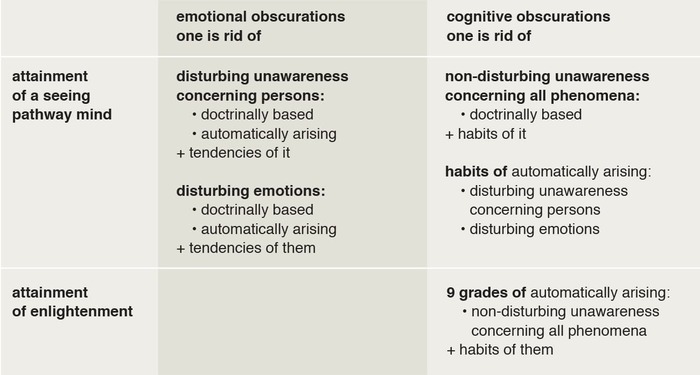The Two Sets of Obscuration
There are two sets of obscuration (sgrib-gnyis, two sets of obstacles) that we need to get rid of forever (spang, abandon) from our mental continuums in order to attain liberation and/or enlightenment. They obscure the mind’s deepest nature and thus obscure the mind’s automatically arising deep awareness (ye-shes lhan-skyes, innate wisdom).
- The emotional obscurations (nyon-sgrib) – obscurations that are disturbing emotions and attitudes and which prevent liberation.
- The cognitive obscurations (shes-sgrib) – obscurations regarding all knowables and which prevent omniscience.
According to the Nyingma and Sakya explanations, the Svatantrika-Madhyamaka and Prasangika-Madhyamaka schools of tenets share the same presentation of the two sets of obscuration. The presentation derives from Maitreya’s Filigree of Realizations (mNgon-rtogs rgyan, Skt. Abhisamaya-alamkara).
- The Gelug and Karma Kagyu traditions assert this presentation only for the Svatantrika tenet system and assert in common a different presentation of the two sets of obscuration for the Prasangika system.
Within the Nyingma and Sakya traditions, various masters explain specific details about this topic differently. Here, we shall represent Nyingma with the explanations given by Mipam (‘Ju Mi-pham) and Sakya with the explanations given by Gorampa (Go-ram bSod-nams seng-ge). Many consider them the mainstream assertions of their respective traditions.
Unawareness Included among the Two Sets of Obscuration
There are two types of unawareness (ma-rig-pa, ignorance) included among the sets of obscuration, one in each set:
- The emotional obscurations include unawareness concerning an impossible soul of persons (gang-zag-gi bdag-med, selflessness of persons)
- The cognitive obscurations include unawareness concerning an impossible soul of all phenomena (chos-kyi bdag-med, selflessness of phenomena).
Because the unawareness concerning persons is one of the disturbing emotions and attitudes, it is called “disturbing unawareness” (ma-rig-pa nyon-mongs-can). Because the unawareness concerning phenomena is a cognitive obscuration and therefore not a disturbing emotion or attitude, it is called “non-disturbing unawareness” (ma-rig-pa nyon-mongs-can min-pa).
There are two levels of impossible soul of a person: coarse and subtle. A coarse impossible soul of a person (gang-zag bdag-med rags-pa) is one that is static, monolithic (partless), and independent of the five aggregates (rtag gcig rang-dbang). A subtle impossible soul of a person (gang-zag bdag-med phra-mo) is one that is self-sufficiently knowable (rang-rkya thub-pa’i rdzas-yod) – validly knowable on its own. The validly knowable “me” (nga) is devoid of existing as either.
The impossible soul of all phenomena refers to the four impossible extreme manners (mtha’-bzhi) in which their existence could be established. The existence of validly knowable phenomena cannot be established as true and unimputed (bden-par grub-pa, true existence), as nonexistent, as both, or as neither. In other words, their existence cannot be established with a category formulated as an affirmation phenomenon (sgrub-pa, affirmingly known phenomenon), with one that is formulated as a negation phenomenon (dgag-pa, negatingly known phenomenon, nullification), with one that is formulated as both, or with one that is formulated as neither.
- A category that is an affirmation phenomenon is one formulated for use in conceptual cognition, and in which an object to be negated (dgag-bya) is not explicitly precluded by the sounds of the words that express it. For example, the category truly existent .
- A category that is a negation phenomenon is one formulated for use in conceptual cognition, and in which an object to be negated is explicitly precluded by the conceptual cognition that cognizes the phenomenon. For example, the category totally devoid of being truly existent is cognized by explicitly precluding or negating the category truly existent, which one has previously cognized.
[See: Affirmation and Negation Phenomena: Gelug Definitions]
All these categories are “impossible souls.” As mental constructs (spros-pa), they are useful initially in logic, but ultimately, nothing actually exists in a manner that can be formulated with any of these concrete categories. Thus, the assertion that the existence of all phenomena is devoid of these four impossible ways of being established is equivalent to the assertion that their existence cannot be established by words and concepts.
The absence of the existence of all phenomena being established in any of these impossible manners is called their “accordant nature beyond words and concepts” (brjod-dang rtog-pa-las 'das de-bzhin-nyid), a non-denumerable ultimate phenomenon (rnam-grangs ma-yin-pa'i don-dam). For ease of discussion, let us call it “voidness beyond words and concepts.”
Gorampa and the mainstream Sakya masters, as well as the masters of the Drikung Kagyu school, assert voidness beyond words and concepts to be “self-voidness” (rang-stong). Self-voidness for him is the absence of the existence of any phenomenon being established in any of the four impossible manners.
Some Nyingma masters, such as Katog Tsewang Norbu (Ka:-thog Tshe-dbang nor-bu), the Sakya master Shakya Chogden (Sha-kya mchog-ldan), as well as the masters of the Jonang (Jo-nang) school, Rime masters such as Jamgon Kongtrul (‘Jam-mgon Kong-sprul Blo-gros mtha’-yas Yon-tan rgya-mtsho), and most masters of the Karma Kagyu and Shangpa Kagyu schools, assert voidness beyond words and concepts to be “other-voidness” (gzhan-stong). Other-voidness refers to the deep awareness (ye-shes, pristine awareness) – an awareness that is deeper than (beyond) conceptual and ordinary non-conceptual levels of mind, and which realizes that the existence of all phenomena cannot be established in any of these four impossible manners.
- For many who assert other-voidness, self-voidness (rang-stong) is merely the absence of existence established as true and unimputed – the voidness of the first extreme. Thus, self-voidness is equivalent to the second extreme. It is still a mental category that is useful at first, but ultimately needs to be dropped in order to gain non-conceptual cognition of the accordant nature beyond words and concepts.
There are two interpretations of the position of Mipam (‘Ju Mi-pham ‘Jam-dbyangs rnam-rgyal rgya-mtsho), made by two wings of his disciples. Botrul (Bod-sprul) and Kenpo Zhenga (mKhan-po gZhan-dga’) present Mipam as asserting self-voidness in the manner of Gorampa, while Zhechen Gyaltsab (Zhe-chen rGyal-tshab Pad-ma rnam-rgyal) and Katog Situ (Kah-thog Si-tu) present him as asserting other-voidness. The first group is mostly at Dzogchen Monastery (rDzogs-chen dGon-pa), while the second is mostly at Zhechen Monastery (Zhe-chen dGon-pa). There is no pervasion, however, that all masters at each of these monasteries share this interpretation and assert the corresponding view.
Disturbing Emotions and Attitudes
Disturbing emotions and attitudes (nyon-mongs, Skt. klesha, afflictive emotions) arise based on unawareness concerning the impossible soul of persons. For ease of discussion, let us refer to disturbing emotions and attitudes merely as “disturbing emotions.”
Disturbing emotions have two levels:
- Doctrinally based disturbing emotions (nyong-rmongs kun-brtags) derive from learning and accepting an Indian non-Buddhist system of tenets. These systems teach that persons are static, monolithic, independent souls – which Buddhism calls a “coarse impossible soul of a person.” An example of a doctrinally based disturbing emotion is attachment for the view of a coarse impossible soul of a person, or attachment for a person imagined to be a coarse impossible soul.
- Automatically arising disturbing emotions (nyon-mongs lhan-skyes) arise without depending on learning and accepting a tenet system. Since it automatically feels as though a person is self-sufficiently knowable – what Buddhism calls a “subtle impossible soul” – the automatically arising disturbing emotions arise based on believing that what we automatically feel about ourselves and others corresponds to reality. An example of an automatically arising disturbing emotion is the attachment that automatically arises for a loved one imagined to be validly knowable on his or her own. When we feel, “I need you,” we are imagining a “you” that can be known independently of a body, mind, and so on.
Although unawareness regarding persons is included among the disturbing emotions, unawareness regarding all phenomena is not included. This is because unawareness regarding all phenomena is a cognitive obscuration regarding all knowables, not an emotional obscuration that is a disturbing emotion or attitude. The two sets of obscuration do not have a common basis (mthun-gzhi, common locus). This means there is no phenomenon that can be included among both sets; there is no phenomenon that is example of both.
Nevertheless, unawareness regarding all phenomena also has doctrinally based and automatically arising forms.
Tendencies and Habits
Tendencies (sa-bon, seeds) and habits (bag-chags, instincts) are both dormant factors (bag-la nyal). As such, they are noncongruent affecting variables (ldan-min ‘du-byed). Being neither forms of physical phenomena (gzugs, forms) nor ways of cognizing something (shes-pa, ways of knowing something), they are nonstatic abstractions that are imputations on a series of similar events. Being nonstatic, they arise from causes and produce results. Often the term bag-chags (habit) appears as an umbrella term for both tendencies and constant habits.
[See: Distinctions between Tendencies & Habits: Gelug Usage]
Tendencies to be gotten rid of (spang-bya) are included among the emotional obscurations. Habits to be gotten rid of are included among the cognitive obscurations.
- Doctrinally based emotional obscurations have only tendencies.
- Automatically arising emotional obscurations have both tendencies and habits.
- Cognitive obscurations, both doctrinally based and automatically arising, have only habits.
Tendencies and habits of ways of cognizing something can only be imputed on a mental continuum so long as they can produce further instances of the ways of cognizing that gave rise to them. Thus, ways of cognizing something and their tendencies or habits are gotten rid of simultaneously. No tendencies or habits remain once the ways of cognizing that gave rise to them have been gotten rid of.
True Stoppings of the Two Sets of Obscuration
With a Seeing Pathway Mind
Bodhisattvas begin to rid themselves of the two sets of obscuration simultaneously. They first attain true stoppings (‘gog-bden, true cessations) of them, such that they never recur, with the achievement of a seeing pathway mind (mthong-lam, path of seeing), the third of the five pathway minds. A seeing pathway mind has non-conceptual, yogic bare cognition (rnal-‘byor mngon-sum) of voidness beyond words and concepts, and thus is a pathway mind of an arya (‘phags-pa, noble one).
With a seeing pathway mind, arya bodhisattvas rid themselves forever of the doctrinally based forms of each set of obscuration. Thus, with a seeing pathway mind, arya bodhisattvas rid themselves of
- Doctrinally based unawareness regarding a coarse impossible soul of a person, and its tendencies
- Doctrinally based disturbing emotions, and their tendencies
- Doctrinally based unawareness concerning all phenomena, and its habits.
Of the ten levels of bhumi mind (sa-bcu, ten bhumis) of arya bodhisattvas, a first-level bhumi mind is equivalent to a seeing pathway mind. The first seven level bhumi minds are called “the seven unpurified bhumi minds” (ma-dag sa-bdun, seven impure bhumis). The eighth through tenth level bhumi minds are called “the three purified bhumi minds” (dag-pa’i sa-gsum, three pure bhumis).
[See: The Five Paths: Advanced Presentation]
With an Accustoming Pathway Mind
Arya bodhisattvas rid themselves of the remaining members of the two sets of obscuration with an accustoming pathway mind (sgom-lam, path of meditation), the fourth of the five pathway minds.
Maitreya explained that the obscurations gotten rid of by an accustoming pathway mind (sgom-spang, abandonments of the path of meditation) have nine grades. Thus, both the emotional obscurations and the cognitive obscurations have nine grades each. Arya bodhisattvas progressively rid themselves of the nine grades with second through tenth-level bhumi minds.
The Indian commentaries to Filigree of Realizations explain Maitreya’s assertion as meaning that arya bodhisattvas finish ridding themselves of both sets of obscuration simultaneously with their attainment of enlightenment. Some of the Tibetan commentaries qualify this and assert that the true stopping of all the automatically arising disturbing emotions is not necessarily pervasive with the true stopping of all nine grades of emotional obscurations. Once arya bodhisattvas have achieved a true stopping of all the automatically arising disturbing emotions, they may still have left on their mental continuums further grades of disturbing emotions that they have not yet gotten rid of. To become Buddhas, arya bodhisattvas must also achieve true stoppings of them as well in order to fulfill the assertion that a true stopping of both sets of obscuration occurs only with the attainment of enlightenment.
Only doctrinally based and automatically arising disturbing emotions – including unawareness concerning persons – are actual disturbing emotions. Once arya bodhisattvas achieve true stoppings of both of them, the remaining grades of disturbing emotions are not actually disturbing emotions. The Nyingma commentaries refer to them as “non-disturbing states of mind labeled with the name disturbing emotions” (nyong-rmongs-kyi ming-btags-pa). For ease of discussion, let us call them “non-disturbing, but labeled as disturbing” disturbing emotions.
- Unawareness concerning all phenomena is also a non-disturbing state of mind, but is not a “non-disturbing, but labeled as disturbing” state of mind.
According to Nyingma and Sakya, “non-disturbing, but labeled as disturbing” disturbing emotions, together with their habits, are included among the cognitive obscurations. They automatically arise and, although they are not emotional obscurations preventing liberation, they can be set as items “labeled as emotional obscurations.” Thus, only with a true stopping of them is there a true stopping of both sets of obscuration. This occurs only with the attainment of enlightenment, and thus through this mechanism, the Nyingma and Sakya explanations satisfy the assertion of Filigree of Realizations. Nyingma and Sakya differ, however, regarding how many of the nine grades gotten rid of by an accustoming pathway mind these “non-disturbing, but labeled as disturbing” disturbing emotions span.
- “Non-disturbing, but labeled as disturbing” unawareness concerning persons, may be explained as unawareness of the fact that their existence cannot be established in any of the four impossible extreme manners: as things that are truly and unimputedly existent, totally nonexistent, both, or neither. Thus, it is a subcategory of non-disturbing unawareness concerning all phenomena.
- “Non-disturbing, but labeled as disturbing” disturbing emotions are based on this “non-disturbing, but labeled as disturbing” unawareness regarding persons.
Summary of the Constituent Members of the Two Sets of Obscuration, in Chart Form
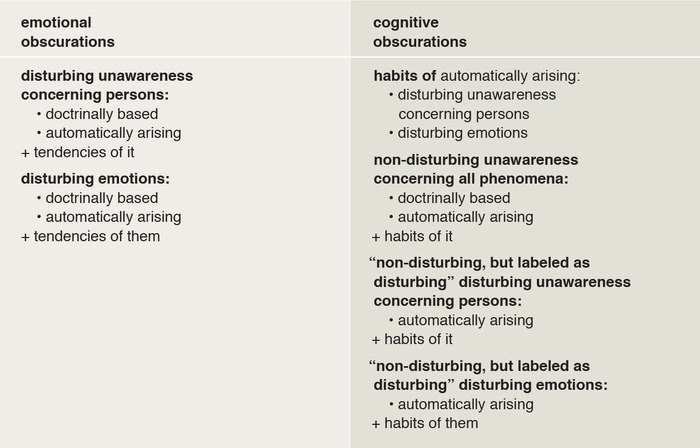
Qualification Added to Satisfy Chandrakirti’s and Aryadeva’s Assertions
Shravakas rid themselves forever of only the emotional obscurations. Nevertheless, in Engaging in the Middle Way (dBu-ma la ‘jug-pa, Skt. Madhyamaka-avatara), the Indian master Chandrakirti wrote, “(Buddha) taught that this lack of a soul that limited beings (need to understand) for liberation is the lack of a soul of phenomena and persons.” Chandrakirti also asserted, “As long as there is grasping at the aggregates, there is grasping for an impossible soul (of a person).”
Moreover, Aryadeva wrote in Four Hundred Verse Treatise on the Middle Way (dBu-ma bzhi-rgya-pa, Skt. Madhyamaka-catuhshataka), “As has been explained, the way in which (a pathway mind) becomes the seer of one phenomenon is the way it becomes the seer of everything. The voidness of one thing (suffices for) the voidness of all things.”
Thus, from the Madhyamaka viewpoint, shravaka aryas must also realize the lack of an impossible soul of phenomena and they must also overcome grasping at their aggregates. Further, the voidness of persons and of all phenomena must be the same. This seemingly contradicts Maitreya’s assertions in Filigree of Realizations that:
- Unawareness of the lack of an impossible soul of persons is an emotional obscuration preventing liberation
- Unawareness of the lack of an impossible soul of all phenomena is a cognitive obscuration preventing omniscience
- Shravaka arhats rid themselves forever only of the emotional obscurations.
The Nyingma and Sakya schools resolve these seeming contradictions by asserting that shravaka aryas realize the lack of an impossible soul of only their own five aggregates, not the lack of an impossible soul of all phenomena in general. This is sufficient to satisfy Chandrakirti’s assertions. Further, the voidness of persons and all phenomena that they realize is not the voidness of existence established in the four extreme manners. It is a more limited voidness and this is sufficient to satisfy Aryadeva’s assertion.
The Nyingma and Sakya positions differ, however, regarding the more limited voidness of all phenomena that shravaka aryas also realize that applies to their aggregates.
- The Nyingma position, formulated by Longchenpa (Klong-chen-pa) and followed by Mipam, is that for shravakas to attain liberation, they need to rid themselves of grasping for their five aggregates to be a partless whole (phung-po-lnga ril-por ‘dzin-pa). Thus, the lack of impossible soul of all phenomena that shravaka aryas realize is the voidness of their five aggregates being a monolith lacking temporal and component parts. The term “phenomenon” (dngos-po) in Aryadeva’s quote can mean either a nonstatic functional phenomenon or a validly knowable phenomenon. Nyingma takes it in the first sense: all nonstatic functional phenomena are devoid of being established as partless monoliths. Understanding this absence regarding one’s own five aggregates constitutes understanding a voidness of all phenomena. As Mipam explained in Lamp of Precious Decisive Awareness (Nges-shes rin-po-che’i sgron-me, Beacon of Certainty), “One cannot say that if one has drunk a single gulp of the water of the great ocean, one has not drunk of the ocean…. (Yet) one cannot say that just by having drunk one gulp, one has drunk the water of the entire ocean.”
- The Sakya position, formulated by Gorampa, takes “phenomenon” in Aryadeva’s quote in its second meaning, a validly knowable phenomenon. Thus, Gorampa asserts that, of the four impossible modes of establishing the existence of their five aggregates, shravaka aryas realize only that their existence cannot be established as true and unimputed. They are devoid of truly and unimputedly established existence (bden-par ma-grub-pa). This voidness also applies to all phenomena.
Three Zillion Eons
A true stopping of both full sets of obscuration and thus the attainment of enlightenment requires three zillion eons for bodhisattvas following the sutra methods. A zillion (grangs-med, countless) is the highest finite number – ten raised to the sixtieth power. Three zillion eons are required to build up enough positive force (bsod-nams, merit) to bring about this attainment.
- The attainment of a seeing pathway mind requires building up positive force over the first zillion eons.
- From then until the attainment of a purified bhumi mind (the eighth level) requires the second zillion eons.
- From then until the attainment of enlightenment requires the third zillion eons.
Special Features of Highest Tantra
Highest tantra in Nyingma refers to dzogchen (rdozgs-chen, great completeness), the highest of the six classes of tantra asserted in Nyingma. In Sakya, highest tantra refers to anuttarayoga (bla-med rnal-‘byor rgyud, highest yoga), the highest of the four classes of tantra asserted in Sakya.
The attainment of enlightenment by a bodhisattva following highest tantra methods does not require three zillion eons of building up positive force. By following the highest tantra methods, bodhisattvas can attain enlightenment within even one lifetime.
Highest tantra lacks the assertion of “non-disturbing, but labeled as disturbing” disturbing emotions. Moreover, bodhisattvas following its methods do not rid themselves simultaneously of the two sets of obscuration with the attainment of enlightenment. They rid themselves completely of the emotional obscurations with the attainment of a seeing pathway mind.
Assertions Specific to Nyingma
Sutra Bodhisattva Pathway Minds
According to Nyingma, practitioners following the bodhisattva sutra methods require a zillion eons of building up positive force sufficient for attaining a seeing pathway mind and, with its non-conceptual, yogic bare cognition of voidness beyond words and concepts, eliminate forever:
- Doctrinally based unawareness regarding persons and its tendencies
- Doctrinally based disturbing emotions and their tendencies
- Doctrinally based unawareness regarding all phenomena and its habits.
The first two are among the emotional obscurations; the third is among the cognitive obscurations.
A second set of zillion eons is required for this non-conceptual, yogic bare cognition to become an eighth-level bhumi mind and eliminate forever:
- The first six of the nine grades of unawareness regarding persons gotten rid of by an accustoming pathway mind – namely, the six automatically arising grades – and their tendencies
- The first six of the nine grades of disturbing emotions gotten rid of by an accustoming pathway mind – namely, the six automatically arising grades – and their tendencies
- The first six of the nine grades of automatically arising unawareness regarding all phenomena gotten rid of by an accustoming pathway mind, and their habits
- The habits of the first six grades of the nine grades of unawareness regarding persons gotten rid of by an accustoming pathway mind – namely, the six automatically arising grades
- The habits of the first six of the nine grades of disturbing emotions gotten rid of by an accustoming pathway mind – namely, the six automatically arising grades.
The first two are among the emotional obscurations; the last three are among the cognitive obscurations. Thus, arya bodhisattvas with sutra pathway minds finish ridding themselves of all actual disturbing emotions when they achieve an eighth-level bhumi mind.
Non-conceptual, yogic bare cognition of voidness beyond words and concepts requires a third set of zillion eons to reach enlightenment, become omniscient awareness (rnam-mkhyen), and eliminate forever:
- The final three of the nine grades of unawareness regarding persons gotten rid of by an accustoming pathway mind – namely, the “non-disturbing, but labeled as disturbing” levels – and their habits
- The final three of the nine grades of disturbing emotions gotten rid of by an accustoming pathway mind – namely, the “non-disturbing, but labeled as disturbing” levels – and their habits
- The final three of the nine grades of automatically arising unawareness regarding all phenomena gotten rid of by an accustoming pathway mind, and their habits.
All three are among the cognitive obscurations, however the “non-disturbing, but labeled as disturbing” items count as portions of emotional obscuration to be gotten rid of.
According to one Nyingma explanation, the three purified bhumi minds are purified in the sense of being purified of all actual disturbing emotions. According to another explanation, they are purified in the sense of being purified of all conceptual cognition (rtog-pa).
Chart of What Bodhisattvas Rid Themselves Of: Nyingma Sutra Presentation
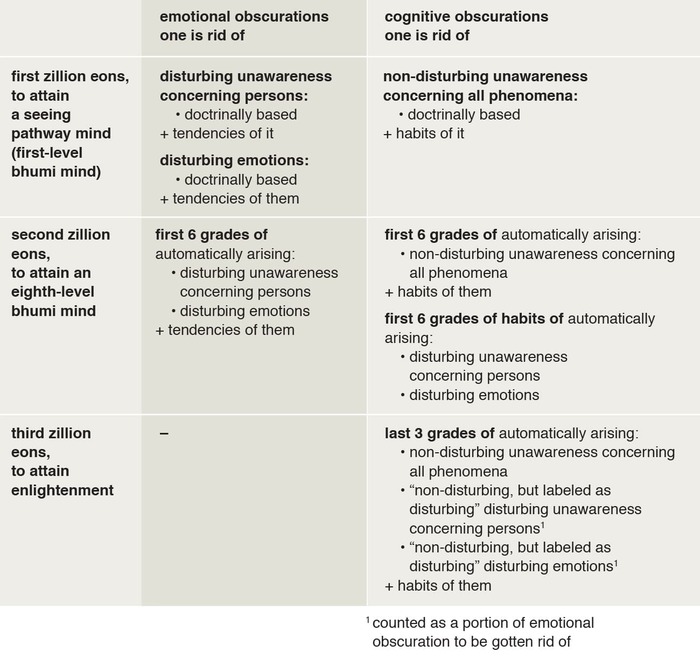
Highest Tantra (Dzogchen) Pathway Minds
There are two types of dzogchen practitioners: those who progress through stages (lam-rim-pa) and those for whom everything happens at once (cig-char-ba).
- The Karma Kagyu presentation of anuttarayoga tantra and dzogchen also assert these two types of practitioners, but its Prasangika presentation of the stages for those who progress through stages agrees with that of Gelug Prasangika.
[See: Dzogchen in Comparison with Other Buddhist Systems]
For those who progress through stages, non-conceptual cognition of voidness beyond words and concepts gained with a seeing pathway mind of rigpa (rig-pa, pure awareness) eliminates forever, all at once:
- Doctrinally based and automatically arising unawareness regarding persons, and its tendencies
- Doctrinally based and automatically arising disturbing emotions, and their tendencies
- Doctrinally based unawareness regarding all phenomena, and its habits.
The first two are among the emotional obscurations; the third is among the cognitive obscurations.
Over the nine arya bodhisattva levels of accustoming pathway mind, their rigpa eliminates forever, with the attainment of enlightenment:
- The nine grades of automatically arising unawareness regarding all phenomena, and their habits.
Chart of What Bodhisattvas Rid Themselves Of: Nyingma Dzogchen Presentation
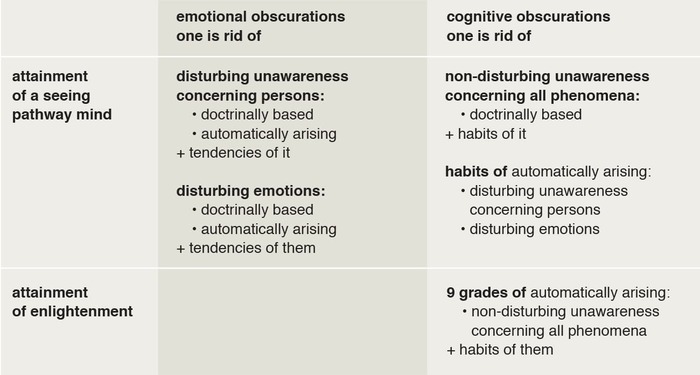
For those for whom everything happens at once, attainment of a seeing pathway mind, an accustoming pathway mind, and an omniscient enlightened mind happen simultaneously. Because of extremely strong tendencies of meditation with rigpa from previous lives, their initial attainment of its non-conceptual cognition of voidness beyond words and concepts in this life removes forever, all at once, the complete sets of emotional and cognitive obscurations.
Assertions Unique to Sakya
Sutra Bodhisattva Pathway Minds
According to Sakya, non-conceptual yogic bare cognition of voidness beyond words and concepts, gained by following the bodhisattva sutra methods, requires a zillion eons to attain a seeing pathway mind and eliminate forever:
- Doctrinally based and automatically arising unawareness regarding persons, and its tendencies
- Doctrinally based and automatically arising disturbing emotions, and their tendencies
- Doctrinally based unawareness regarding all phenomena, and its habits.
The first two are among the emotional obscurations; the third is among the cognitive obscurations.
The Sakya assertion that a seeing pathway mind of an arya bodhisattva following sutra methods eliminates both doctrinally based and automatically arising levels of unawareness concerning persons and of disturbing emotions, and the appropriate tendencies and habits, resembles the Nyingma assertion for bodhisattvas following the dzogchen methods and who progress through stages. Nevertheless, the Sakya sutra presentation still follows the assertion of Filigree of Realizations that the two sets of obscuration are gotten rid of simultaneously with the attainment of enlightenment. Therefore, Sakya asserts all nine levels of unawareness concerning persons gotten rid of by an accustoming pathway mind and all nine levels of disturbing emotions gotten rid of by an accustoming pathway mind to be “non-disturbing, but labeled as disturbing”states of mind.
A second set of zillion eons is required for an arya bodhisattva’s non-conceptual yogic bare cognition to become an eighth-level bhumi mind and eliminate forever:
- The first six of the nine grades of unawareness regarding persons gotten rid of by an accustoming pathway mind – which are automatically arising “non-disturbing, but labeled as disturbing” levels – and their habits
- The first six of the nine grades of disturbing emotions gotten rid of by an accustoming pathway mind – which are automatically arising “non-disturbing, but labeled as disturbing” levels – and their habits
- The first six of the nine grades of automatically arising unawareness regarding all phenomena gotten rid of by an accustoming pathway mind, and their habits.
All three groupings are among the cognitive obscurations, however the “non-disturbing, but labeled as disturbing” items count as portions of emotional obscuration to be gotten rid of. Nyingma does not assert any “non-disturbing, but labeled as disturbing” items to be gotten rid of by an accustoming pathway mind during this second set of zillion eons.
Yogic non-conceptual cognition of voidness requires a third set of zillion eons to eliminate forever:
- The final three of the nine grades of unawareness regarding persons gotten rid of by an accustoming pathway mind – which are automatically arising “non-disturbing, but labeled as disturbing” levels – and their habits
- The final three of the nine grades of disturbing emotions gotten rid of by an accustoming pathway mind – which are automatically arising “non-disturbing, but labeled as disturbing” levels – and their habits
- The final three of the nine grades of automatically arising unawareness regarding all phenomena gotten rid of by an accustoming pathway mind, and their habits.
As Nyingma also asserts, all three groupings are among the cognitive obscurations, however the “non-disturbing, but labeled as disturbing” items count as portions of emotional obscuration to be gotten rid of.
According to one Sakya explanation, the last three levels of bhumi mind are purified in the sense of being effortlessly and spontaneously able to enter total absorption on voidness beyond words and concepts. According to another explanation, they are purified in the sense of arya bodhisattvas of lower capacities being purified of the danger of developing the thought that entering a Hinayana style nirvana might be something preferable to do.
Chart of What Bodhisattvas Rid Themselves Of: Sakya Sutra Presentation
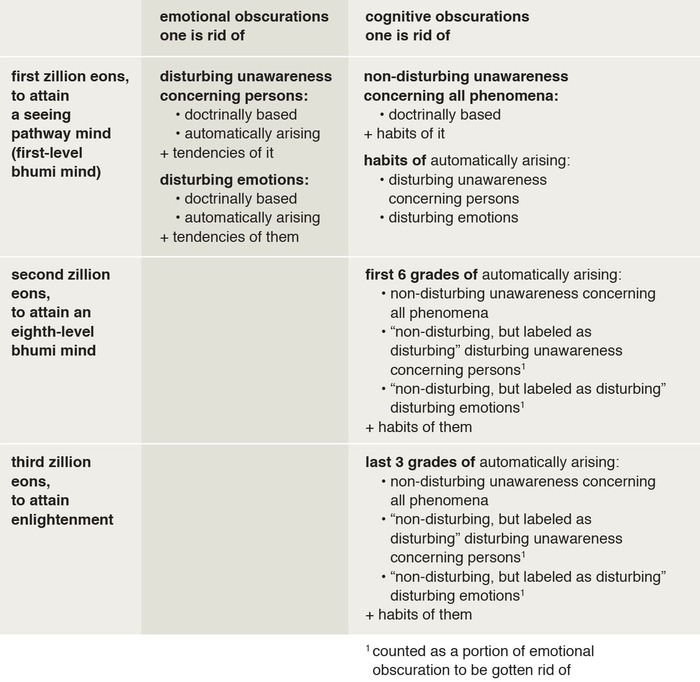
Highest Tantra (Anuttarayoga) Pathway Minds
Sakya does not assert practitioners for whom everything happens at once. As in Gelug, all practitioners of bodhisattva sutra and highest tantra progress in stages.
According to the Sakya presentation, anuttarayoga and sutra practitioners both rid themselves of the same items with a seeing pathway mind. The more efficient anuttarayoga methods, however, obviate the necessity for building up positive force over a zillion eons in order to attain such a seeing pathway mind. Sakya further asserts that anuttarayoga practitioners rid themselves of the same items with an accustoming mind as do dzogchen practitioners who progress in stages.
Chart of What Bodhisattvas Rid Themselves Of: Sakya Anuttarayoga Tantra Presentation
